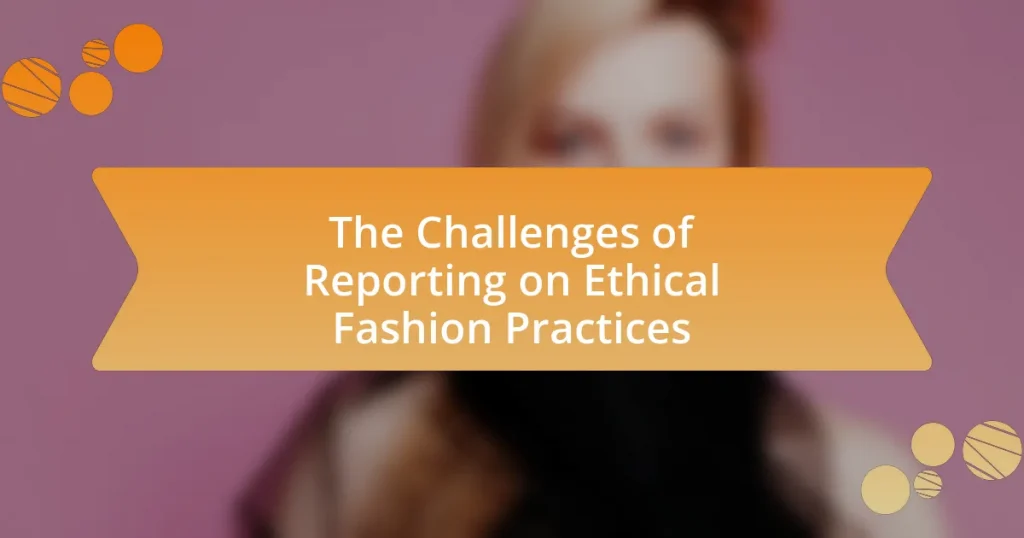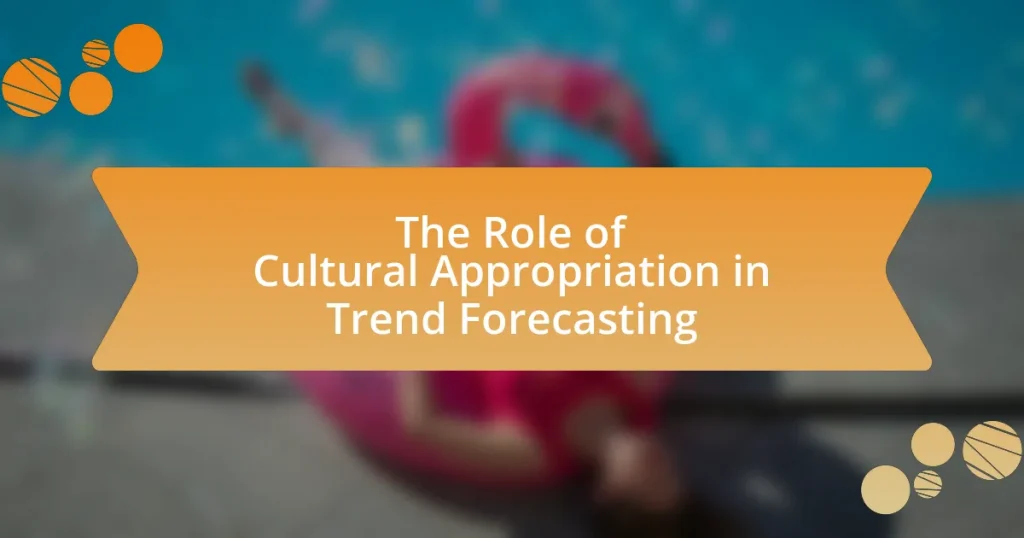The article examines the challenges of reporting on ethical fashion practices, highlighting issues such as a lack of transparency, difficulties in verifying brand claims, and the complexities of global supply chains. It emphasizes the significance of transparency for consumer trust and accountability, noting that many brands fail to disclose essential information about their sourcing and labor practices. Additionally, the article discusses the conflicting definitions of ethical fashion, the impact of media biases on public perception, and the role of investigative journalism in uncovering unethical practices. Strategies for improving reporting accuracy and fostering transparency through collaboration with ethical brands are also explored.
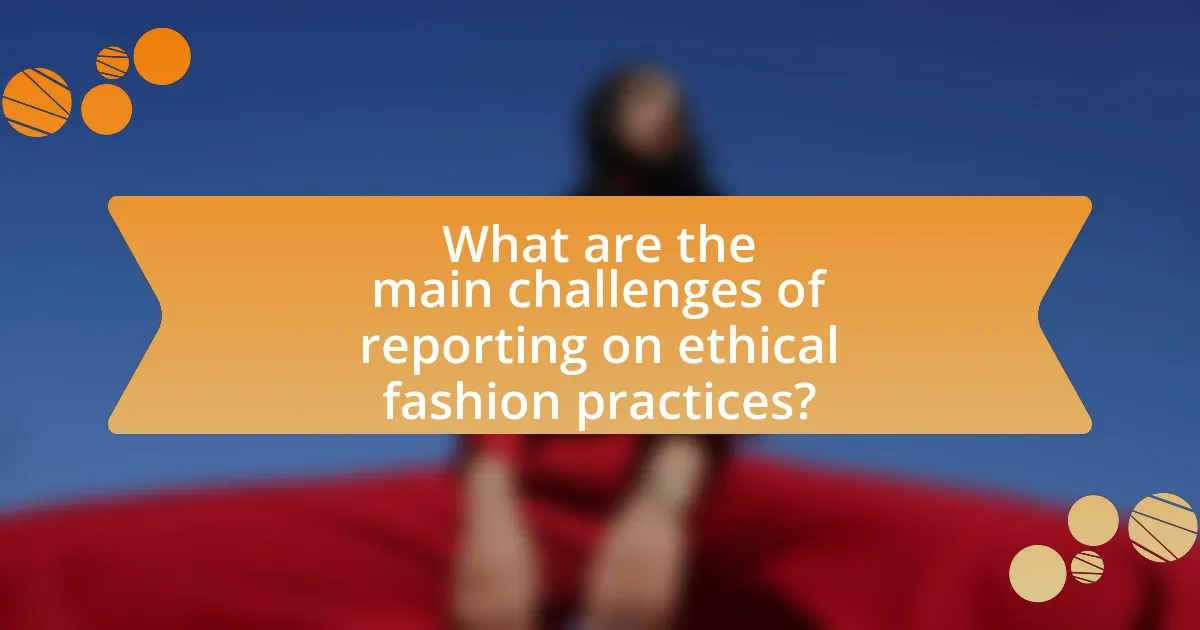
What are the main challenges of reporting on ethical fashion practices?
The main challenges of reporting on ethical fashion practices include a lack of transparency within the industry, difficulty in verifying claims made by brands, and the complexity of supply chains. Transparency is often limited, as many companies do not disclose their sourcing and labor practices, making it hard for journalists to obtain accurate information. Additionally, brands may make unverified claims about their sustainability efforts, leading to misinformation. The intricate nature of global supply chains further complicates reporting, as multiple stakeholders are involved, each with varying degrees of ethical compliance. These factors collectively hinder the ability to provide a clear and truthful narrative about ethical fashion practices.
Why is transparency a significant issue in ethical fashion reporting?
Transparency is a significant issue in ethical fashion reporting because it directly affects consumer trust and accountability within the industry. When brands fail to disclose information about their supply chains, labor practices, and environmental impact, consumers cannot make informed choices, which undermines the principles of ethical fashion. According to a 2021 report by Fashion Revolution, 60% of consumers want to know more about the origins of their clothing, highlighting the demand for transparency. Without clear and accessible information, brands can mislead consumers about their ethical practices, perpetuating greenwashing and eroding the credibility of genuine ethical initiatives.
How does lack of transparency affect consumer trust?
Lack of transparency significantly undermines consumer trust by creating uncertainty about product sourcing, manufacturing practices, and ethical standards. When consumers are unable to access clear information regarding how and where products are made, they are less likely to feel confident in the brand’s integrity. Research conducted by the Ethical Consumer organization found that 73% of consumers are more likely to trust brands that provide transparent information about their supply chains. This lack of clarity can lead to skepticism and a perception that brands may be hiding unethical practices, ultimately resulting in decreased customer loyalty and potential loss of sales.
What role do brands play in promoting transparency?
Brands play a crucial role in promoting transparency by openly sharing information about their supply chains, production processes, and sourcing practices. This transparency fosters consumer trust and accountability, as brands that disclose their ethical practices are more likely to attract socially conscious consumers. For instance, a 2021 report by Fashion Revolution found that 79% of consumers want to know where their clothes come from, highlighting the demand for transparency in the fashion industry. By providing detailed insights into their operations, brands not only comply with increasing regulatory pressures but also differentiate themselves in a competitive market, ultimately driving positive change within the industry.
How do conflicting definitions of ethical fashion complicate reporting?
Conflicting definitions of ethical fashion complicate reporting by creating ambiguity in standards and expectations. Different stakeholders, such as brands, consumers, and advocacy groups, often have varying interpretations of what constitutes ethical practices, leading to inconsistent messaging. For instance, while some may prioritize sustainable materials, others may focus on fair labor practices, resulting in a fragmented understanding of ethical fashion. This lack of consensus makes it challenging for reporters to accurately convey the complexities of ethical fashion, as they must navigate these divergent viewpoints and assess the credibility of claims made by different parties. Consequently, reporting can become misleading or oversimplified, failing to capture the multifaceted nature of ethical fashion.
What are the various interpretations of ethical fashion?
Ethical fashion can be interpreted in several ways, primarily focusing on sustainability, labor rights, and animal welfare. Sustainability emphasizes environmentally friendly practices, such as using organic materials and reducing waste, which is supported by the Global Fashion Agenda’s 2021 report highlighting the industry’s need to reduce its carbon footprint. Labor rights interpretation centers on fair wages and safe working conditions for garment workers, as evidenced by the Fashion Revolution’s annual Fashion Transparency Index, which assesses brands on their labor practices. Lastly, animal welfare concerns address the humane treatment of animals in the fashion supply chain, with organizations like PETA advocating for cruelty-free materials. Each interpretation reflects a different aspect of ethical considerations in the fashion industry, contributing to a broader understanding of what constitutes ethical fashion.
How do these interpretations impact journalistic integrity?
Interpretations of ethical fashion practices significantly impact journalistic integrity by influencing the accuracy and objectivity of reporting. When journalists interpret ethical standards subjectively, they may present biased narratives that misrepresent facts, leading to misinformation. For instance, a study by the Ethical Fashion Forum found that 70% of consumers rely on media reports to make informed decisions about ethical brands, highlighting the responsibility of journalists to provide clear and factual information. This reliance underscores the importance of maintaining integrity, as misinterpretations can erode public trust and diminish the credibility of the media.
What are the limitations of sourcing information in ethical fashion?
The limitations of sourcing information in ethical fashion include a lack of transparency in supply chains, inconsistent standards across organizations, and the prevalence of greenwashing. Many brands do not disclose detailed information about their sourcing practices, making it difficult for consumers and researchers to verify claims of ethical production. For instance, a 2021 report by Fashion Revolution found that only 40% of brands disclose their suppliers, which hinders accountability. Additionally, varying definitions of what constitutes “ethical” can lead to confusion and misrepresentation, as different organizations may prioritize different aspects of sustainability. Furthermore, greenwashing, where companies exaggerate or falsely claim their sustainability efforts, complicates the sourcing of reliable information, as seen in numerous cases where brands have faced backlash for misleading marketing.
How do supply chain complexities hinder accurate reporting?
Supply chain complexities hinder accurate reporting by introducing multiple layers of operations, stakeholders, and data sources that can obscure transparency. These complexities often result in inconsistent data collection methods, making it difficult to obtain reliable information on ethical practices. For instance, a study by the World Economic Forum highlights that 79% of companies lack end-to-end visibility in their supply chains, which directly impacts their ability to report on sustainability and ethical standards accurately. This lack of visibility can lead to discrepancies in reporting, as companies may rely on outdated or incomplete information, ultimately undermining the credibility of their ethical claims.
What challenges do journalists face in verifying claims made by brands?
Journalists face significant challenges in verifying claims made by brands, primarily due to a lack of transparency and access to reliable data. Many brands may provide misleading information or omit critical details about their practices, making it difficult for journalists to ascertain the truth. For instance, brands often use vague language in their sustainability claims, which can lead to misinterpretation. Additionally, the complexity of supply chains in the fashion industry complicates verification, as journalists may struggle to trace the origins of materials or labor practices. Furthermore, brands may not disclose third-party audits or certifications, limiting journalists’ ability to validate claims independently. These factors contribute to a challenging environment for accurate reporting on ethical fashion practices.
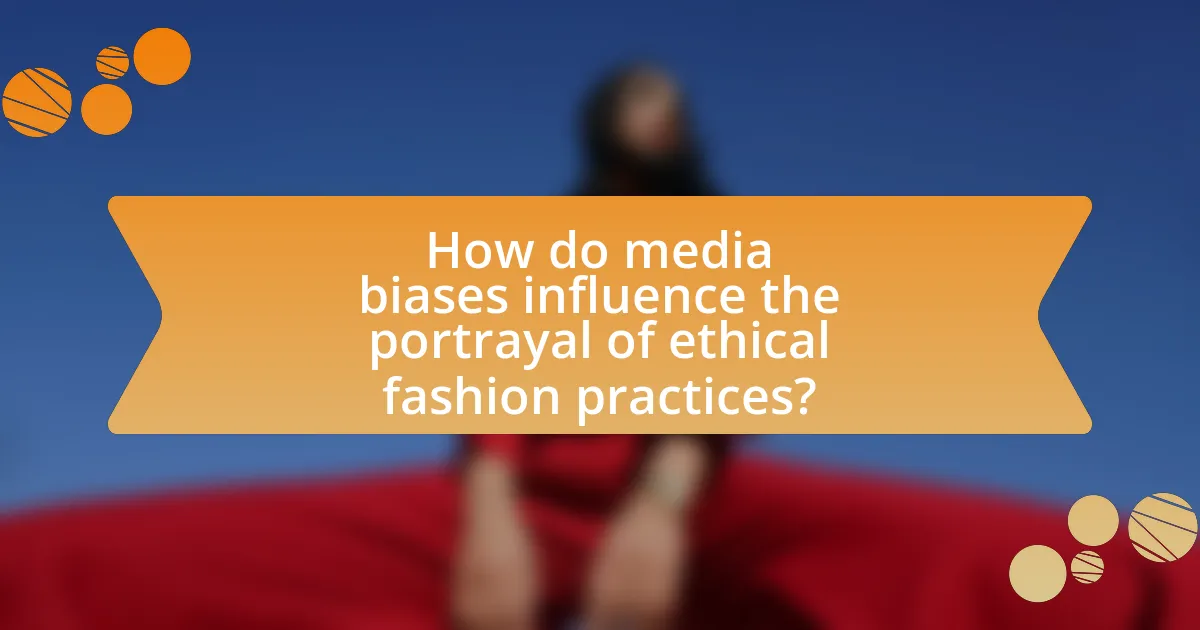
How do media biases influence the portrayal of ethical fashion practices?
Media biases significantly influence the portrayal of ethical fashion practices by shaping narratives that either highlight or downplay the complexities involved. For instance, media outlets may emphasize sensational stories of unethical practices in fast fashion while neglecting positive developments in ethical brands, leading to a skewed public perception. Research indicates that framing effects in media coverage can lead to a misrepresentation of the ethical fashion landscape, as seen in studies where positive initiatives by sustainable brands receive less attention compared to negative reports on labor practices in conventional fashion. This selective reporting can create a distorted understanding of ethical fashion, impacting consumer behavior and brand reputation.
What types of biases are commonly found in fashion journalism?
Fashion journalism commonly exhibits biases such as elitism, gender bias, and cultural appropriation. Elitism manifests through a focus on high-end brands and luxury fashion, often sidelining sustainable or ethical practices that are more accessible. Gender bias is prevalent, with coverage frequently favoring women’s fashion over men’s, perpetuating stereotypes and limiting representation. Cultural appropriation bias occurs when fashion journalism appropriates elements from marginalized cultures without proper acknowledgment or respect, leading to misrepresentation and exploitation. These biases hinder a comprehensive understanding of ethical fashion practices and can perpetuate harmful narratives within the industry.
How do these biases affect public perception of ethical fashion?
Biases significantly distort public perception of ethical fashion by creating misconceptions about its accessibility and effectiveness. For instance, the belief that ethical fashion is only for affluent consumers leads to the exclusion of lower-income individuals from the conversation, thereby limiting the market’s growth and acceptance. Additionally, biases regarding the effectiveness of ethical practices can result in skepticism about the impact of sustainable fashion initiatives, as seen in studies indicating that consumers often doubt the authenticity of brands’ ethical claims. This skepticism can diminish consumer trust and willingness to engage with ethical fashion, ultimately hindering its broader acceptance and market viability.
What can be done to mitigate these biases in reporting?
To mitigate biases in reporting on ethical fashion practices, journalists should implement diverse sourcing and fact-checking protocols. By including voices from various stakeholders, such as workers, activists, and industry experts, reporters can present a more balanced perspective. Research indicates that diverse teams produce more comprehensive coverage, as shown in a study by the American Press Institute, which found that diverse newsrooms are better at addressing issues relevant to underrepresented communities. Additionally, employing rigorous fact-checking processes can help ensure accuracy and reduce the influence of personal biases, as evidenced by the Poynter Institute’s findings that fact-checking improves the credibility of news reports.
How does the audience’s understanding of ethical fashion impact reporting?
The audience’s understanding of ethical fashion significantly impacts reporting by shaping the narrative and focus of the content produced. When audiences are well-informed about ethical fashion, reporters are more likely to emphasize transparency, sustainability, and labor practices in their stories, reflecting the values and concerns of their readers. For instance, a study by the Ethical Fashion Forum found that 66% of consumers are willing to pay more for sustainable products, indicating a demand for responsible reporting that aligns with audience values. This understanding drives journalists to investigate and highlight brands that adhere to ethical practices, thereby influencing public perception and consumer behavior.
What misconceptions do consumers have about ethical fashion?
Consumers often believe that ethical fashion is prohibitively expensive, which is a misconception. While some ethical brands do have higher price points due to sustainable practices and fair labor, many affordable options exist that prioritize ethical standards. For instance, a report by the Ethical Fashion Forum indicates that a growing number of brands are offering ethically produced clothing at competitive prices, making it accessible to a wider audience. Additionally, consumers may think that ethical fashion lacks variety and style; however, numerous designers are now creating fashionable, trendy pieces that adhere to ethical guidelines, demonstrating that style and ethics can coexist.
How can journalists educate their audience on ethical practices?
Journalists can educate their audience on ethical practices by providing clear, factual reporting on the principles of ethical journalism, including accuracy, fairness, and accountability. They can achieve this through workshops, articles, and social media campaigns that explain these principles and their importance in the context of ethical fashion practices. For instance, the Society of Professional Journalists outlines a code of ethics that emphasizes the need for journalists to seek truth and report it, which can serve as a foundational resource for educating the public. By actively engaging with their audience and sharing case studies of ethical dilemmas in fashion reporting, journalists can foster a deeper understanding of ethical practices and encourage critical thinking among their readers.
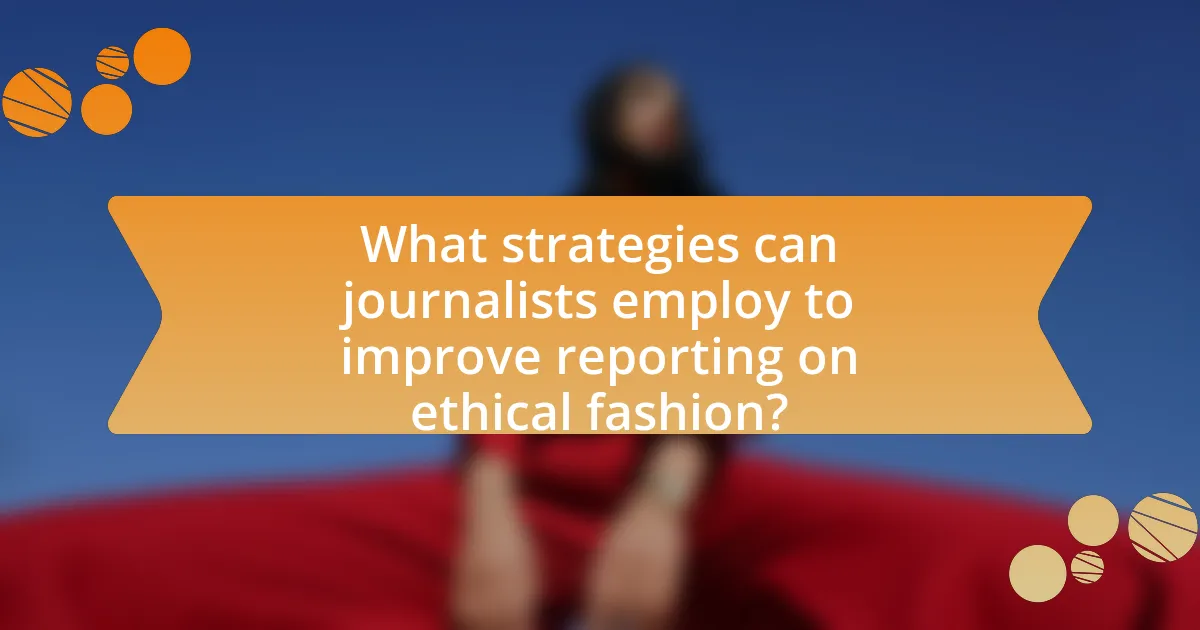
What strategies can journalists employ to improve reporting on ethical fashion?
Journalists can improve reporting on ethical fashion by employing strategies such as conducting thorough research, collaborating with experts, and utilizing transparent sourcing. Thorough research allows journalists to gather accurate data on supply chains, labor practices, and environmental impacts, which is essential for informed reporting. Collaborating with experts in sustainability and ethical practices provides journalists with credible insights and enhances the depth of their stories. Utilizing transparent sourcing, including direct quotes from brands and workers, fosters accountability and builds trust with the audience. These strategies are supported by the increasing demand for transparency in the fashion industry, as evidenced by the 2021 Fashion Transparency Index, which found that only 23% of major fashion brands disclose their supply chain information.
How can collaboration with ethical brands enhance reporting accuracy?
Collaboration with ethical brands can enhance reporting accuracy by providing verified data and transparency in supply chain practices. Ethical brands often prioritize accountability and sustainability, which leads to more reliable information regarding sourcing, labor conditions, and environmental impact. For instance, brands that adhere to certifications like Fair Trade or GOTS (Global Organic Textile Standard) are required to maintain rigorous documentation and audits, ensuring that the data reported is accurate and trustworthy. This commitment to transparency not only improves the credibility of the reports but also fosters consumer trust, as evidenced by studies showing that consumers are more likely to support brands that demonstrate ethical practices.
What are the benefits of partnerships between journalists and ethical brands?
Partnerships between journalists and ethical brands enhance credibility and promote transparency in reporting. Journalists gain access to reliable information and insights about ethical practices, which strengthens their narratives and informs the public accurately. Ethical brands benefit from increased visibility and trust, as their commitment to responsible practices is highlighted through credible journalism. This collaboration can lead to a more informed audience, fostering consumer awareness and encouraging sustainable choices. Research indicates that consumers are more likely to support brands that are transparently reported on, thus driving positive change in the fashion industry.
How can these collaborations foster greater transparency?
Collaborations among stakeholders in the fashion industry can foster greater transparency by facilitating the sharing of information and best practices. When brands, suppliers, and NGOs work together, they create a platform for open dialogue, which helps to standardize ethical practices and reporting methods. For instance, initiatives like the Ethical Fashion Initiative promote transparency by requiring participants to disclose their supply chain processes, thereby holding each other accountable. This collaborative approach not only enhances trust among consumers but also encourages adherence to ethical standards, as evidenced by the increased consumer demand for transparency in brands, with 73% of millennials willing to pay more for sustainable products according to a Nielsen report.
What role does investigative journalism play in ethical fashion reporting?
Investigative journalism plays a crucial role in ethical fashion reporting by uncovering the truth behind fashion supply chains and exposing unethical practices. This form of journalism conducts in-depth research and analysis, revealing issues such as labor exploitation, environmental degradation, and lack of transparency within the fashion industry. For instance, investigations by organizations like Fashion Revolution have highlighted the working conditions in garment factories, prompting brands to adopt more ethical practices. By providing evidence-based insights, investigative journalism holds companies accountable and informs consumers, thereby fostering a more ethical fashion landscape.
How can investigative techniques uncover hidden practices in the fashion industry?
Investigative techniques can uncover hidden practices in the fashion industry by employing methods such as undercover reporting, data analysis, and whistleblower testimonies. Undercover reporting allows journalists to observe and document unethical labor practices, such as sweatshop conditions, firsthand, providing concrete evidence of exploitation. Data analysis can reveal discrepancies in supply chain transparency, highlighting areas where brands may misrepresent their ethical commitments. Whistleblower testimonies from industry insiders can expose systemic issues, such as environmental violations or labor abuses, that are often concealed from public scrutiny. For instance, the 2013 Rana Plaza collapse in Bangladesh, which killed over 1,100 garment workers, was a result of investigative reporting that brought attention to unsafe working conditions in the fashion supply chain. This incident led to increased scrutiny and reforms in industry practices, demonstrating the effectiveness of investigative techniques in promoting accountability.
What are some successful examples of investigative reporting in ethical fashion?
Successful examples of investigative reporting in ethical fashion include the 2013 expose by the BBC on the Rana Plaza disaster, which highlighted unsafe working conditions in garment factories in Bangladesh. This investigation revealed that over 1,100 workers died due to building collapses, prompting global scrutiny and reforms in labor practices. Another notable example is the 2018 report by The Guardian, which uncovered the exploitation of workers in the fast fashion supply chain, leading to increased awareness and calls for transparency from major brands. These investigations have significantly influenced public perception and policy regarding ethical fashion practices.
What best practices should journalists follow when reporting on ethical fashion?
Journalists should prioritize transparency and accuracy when reporting on ethical fashion. This involves thoroughly researching brands’ supply chains, verifying claims of sustainability, and ensuring that information is sourced from credible experts or organizations. For instance, the Fashion Transparency Index provides data on how brands disclose their practices, which can be used to assess their ethical claims. Additionally, journalists should highlight the voices of marginalized communities affected by fashion practices, ensuring diverse perspectives are represented. This approach not only enriches the narrative but also fosters accountability within the industry.
